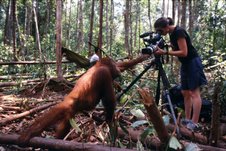Gibbon Research In Sebangau
Dr Susan Cheyne
Pre-Dawn Interview in Sebangau National Park
0400 Hours and we're setting off into the forest with Susan.
SC: "We’re now at the junction of transect zero, which is our main transect into the forest, and transect B. We’re more or less in the centre of group C’s territory, so, because we don’t know exactly where they are going to sing, we wait in the middle of the territory and that means when they do start singing we’re very well placed to go after them."
"Most of the 11 gibbon species… 9 of them have these duets where the male and female have very distinct songs. The Javan gibbon doesn’t and the Kloss gibbon doesn’t, we’re not entirely sure why, but the rest of them have these very distinct male and female parts and within that the female’s the most distinctive, she has the longest and loudest call, that part of the song is called the “great call”."
Pram: "How many gibbons in this area, Susan?"
SC: "In the grid system, which is 2km2, we have 12 groups, and if we average 4 gibbons per group – that’s 48. It’s not high-density forest, but there are definitely gibbons here and we reckon this is probably the largest population of gibbons in Indonesia at around 30,000 animals, if you include the whole Sebangau, not this particular area."
"We’re looking mainly at the feeding ecology of gibbons, the types of trees that make up the majority of their diet, which part of those trees they’re eating, whether it be the fruit or the seeds or the leaves or flowers, and we’re also collecting samples of the all the food the gibbons eat to do mechanical and nutritional analysis on, to actually work out how much energy they are actually getting from the food. We’re also, because noone has studied the gibbons here before, we’re also doing behavioural study, looking at where they go, what they do, group interactions, interactions between gibbons and orangutans and indeed gibbons and any other animals, to build up a good overall picture of the behaviour of gibbons in this forest."
"As I said before, gibbons here are at quite low density, but there certainly are gibbons here, they’re certainly thriving and they’re definitely reproducing. So, we’re wanting to understand how they’re managing to survive, first of all in a relatively low-productivity peat-swamp forest, and second – a low productivity peat-swamp forest that had been a logging concession for 30 years."
"This here is… we actually did this because orangutans eat the bark of this tree, and what they actually want is this sap and the cambium which is underneath the bark, so they actually get the tree and strip the bark themselves. Because its an orangutan food and that’s part of Mark’s study, which is the comparison to mine between orangutans and gibbons in this forest, we had to get samples of the bark to send off to the lab in Bogor for nutritional analysis. When we’re taking samples from trees and things like this, especially taking bark, we take it from many different trees, there’s no way we could take enough bark from one tree without doing a lot of damage."
"Right, the gibbons are singing so we better go… so now we go and find them!"
See the video above to find out more about our morning in the forest following the gibbons. This blog entry is a precursor to a broadcast project we are developing with Susan and Chanee.
Pre-Dawn Interview in Sebangau National Park
0400 Hours and we're setting off into the forest with Susan.
SC: "We’re now at the junction of transect zero, which is our main transect into the forest, and transect B. We’re more or less in the centre of group C’s territory, so, because we don’t know exactly where they are going to sing, we wait in the middle of the territory and that means when they do start singing we’re very well placed to go after them."
"Most of the 11 gibbon species… 9 of them have these duets where the male and female have very distinct songs. The Javan gibbon doesn’t and the Kloss gibbon doesn’t, we’re not entirely sure why, but the rest of them have these very distinct male and female parts and within that the female’s the most distinctive, she has the longest and loudest call, that part of the song is called the “great call”."
Pram: "How many gibbons in this area, Susan?"
SC: "In the grid system, which is 2km2, we have 12 groups, and if we average 4 gibbons per group – that’s 48. It’s not high-density forest, but there are definitely gibbons here and we reckon this is probably the largest population of gibbons in Indonesia at around 30,000 animals, if you include the whole Sebangau, not this particular area."
"We’re looking mainly at the feeding ecology of gibbons, the types of trees that make up the majority of their diet, which part of those trees they’re eating, whether it be the fruit or the seeds or the leaves or flowers, and we’re also collecting samples of the all the food the gibbons eat to do mechanical and nutritional analysis on, to actually work out how much energy they are actually getting from the food. We’re also, because noone has studied the gibbons here before, we’re also doing behavioural study, looking at where they go, what they do, group interactions, interactions between gibbons and orangutans and indeed gibbons and any other animals, to build up a good overall picture of the behaviour of gibbons in this forest."
"As I said before, gibbons here are at quite low density, but there certainly are gibbons here, they’re certainly thriving and they’re definitely reproducing. So, we’re wanting to understand how they’re managing to survive, first of all in a relatively low-productivity peat-swamp forest, and second – a low productivity peat-swamp forest that had been a logging concession for 30 years."
"This here is… we actually did this because orangutans eat the bark of this tree, and what they actually want is this sap and the cambium which is underneath the bark, so they actually get the tree and strip the bark themselves. Because its an orangutan food and that’s part of Mark’s study, which is the comparison to mine between orangutans and gibbons in this forest, we had to get samples of the bark to send off to the lab in Bogor for nutritional analysis. When we’re taking samples from trees and things like this, especially taking bark, we take it from many different trees, there’s no way we could take enough bark from one tree without doing a lot of damage."
"Right, the gibbons are singing so we better go… so now we go and find them!"
See the video above to find out more about our morning in the forest following the gibbons. This blog entry is a precursor to a broadcast project we are developing with Susan and Chanee.





